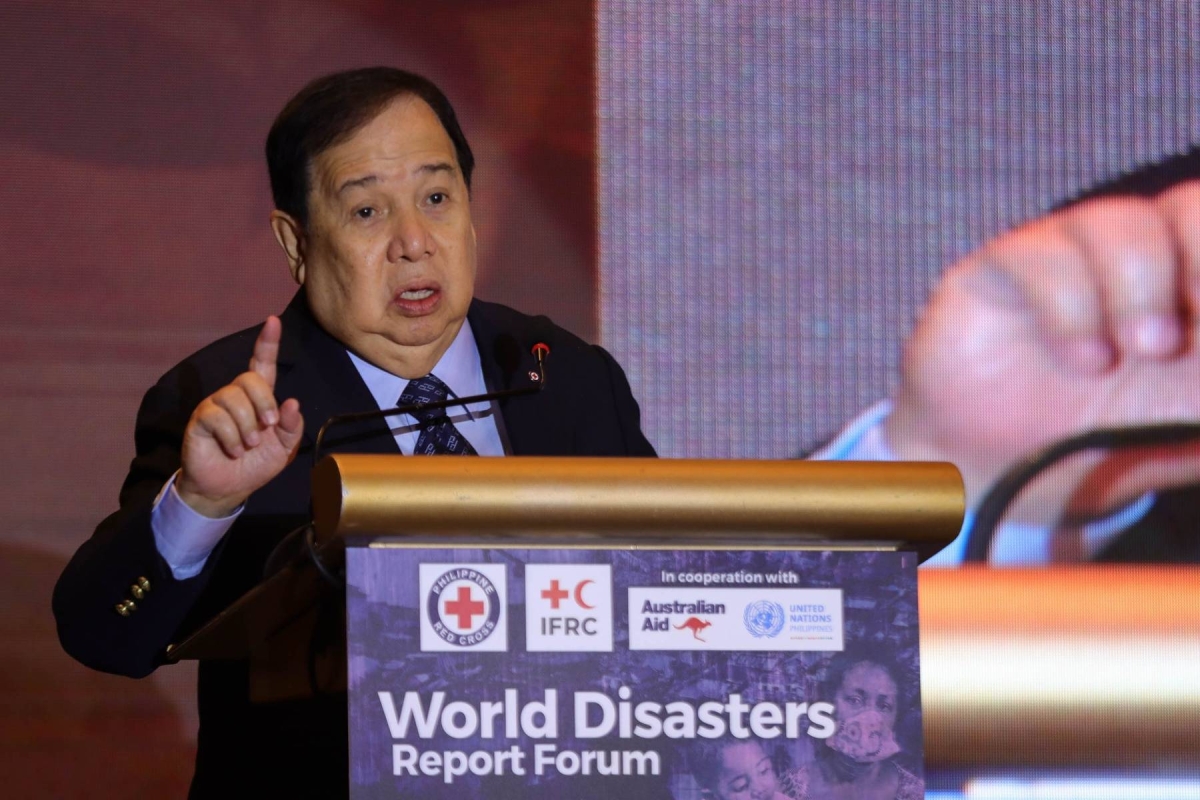Introduction to the IFRC 2022 World Disasters Report
The International Federation of Red Cross and Red Crescent Societies (IFRC) plays a pivotal role in global disaster response, offering critical support and resources to communities affected by crises. With a network spanning over 190 National Societies, the IFRC is uniquely positioned to coordinate and deliver humanitarian aid, ensuring rapid and effective assistance during emergencies. This extensive reach enables the organization to address diverse challenges, from natural disasters to health emergencies, thereby mitigating their impact on vulnerable populations.
The 2022 World Disasters Report, published by the IFRC, underscores the significance of enhancing disaster preparedness, particularly in the context of pandemics. This comprehensive report presents a thorough analysis of global disaster trends, emphasizing the urgent need for improved strategies and mechanisms to cope with future crises. As the world continues to grapple with the repercussions of the COVID-19 pandemic, the insights provided by the report are invaluable for policymakers, humanitarian organizations, and communities aiming to bolster their resilience against similar threats.
Central to the 2022 report is the emphasis on proactive preparedness measures. The document advocates for the integration of pandemic preparedness into broader disaster management frameworks, highlighting the necessity of adaptive and flexible response systems. By drawing lessons from recent experiences, the report calls for a paradigm shift towards more anticipatory and inclusive approaches, ensuring that preparedness efforts are comprehensive and equitable.
Ultimately, the IFRC 2022 World Disasters Report serves as a crucial reminder of the interconnected nature of global challenges and the need for collective action. By spotlighting areas for improvement and offering practical recommendations, the report aims to foster a more resilient and responsive global community, better equipped to face future pandemics and other disasters. Through this endeavor, the IFRC continues to uphold its mission of alleviating human suffering and promoting humanitarian values across the globe.
The Impact of COVID-19: A Global Perspective
The International Federation of Red Cross and Red Crescent Societies (IFRC) 2022 World Disasters Report identifies the COVID-19 pandemic as the ‘biggest disaster in living memory.’ This characterization underscores the unprecedented magnitude of the crisis, which claimed the lives of approximately 6.5 million people globally within a span of just three years. The pandemic’s reach and severity have left an indelible mark on nearly every aspect of human life, from health and economy to social structures and international relations.
The global impact of the COVID-19 pandemic has been profound and multifaceted. Different countries faced varying degrees of challenges based on their preparedness and response strategies. Developed nations with robust healthcare systems and advanced infrastructure were initially perceived to be better equipped to handle the crisis. However, even these countries faced significant hurdles, including overwhelming healthcare facilities, shortages of medical supplies, and economic downturns. On the other hand, developing nations struggled with limited resources, inadequate healthcare infrastructure, and socio-economic vulnerabilities, exacerbating the pandemic’s toll.
The report highlights significant disparities in the pandemic response across different regions. In Asia, countries like South Korea and Taiwan implemented swift and comprehensive measures, including widespread testing, contact tracing, and stringent quarantine protocols, which helped mitigate the spread of the virus. European nations like Italy and Spain, despite being highly developed, experienced severe outbreaks early on, revealing gaps in preparedness and response mechanisms. In contrast, some African countries leveraged their experiences with previous epidemics such as Ebola to implement effective public health interventions, despite facing considerable resource constraints.
These variations in preparedness and response underscore the importance of strengthening global disaster preparedness frameworks. The COVID-19 pandemic has illustrated that no country is immune to the impacts of global health crises, and collective efforts are essential to enhance resilience against future pandemics. By learning from the successes and shortcomings observed during this pandemic, nations can better equip themselves to handle similar challenges in the future, ultimately safeguarding the health and well-being of populations worldwide.
The initial response to the COVID-19 pandemic showcased significant challenges and confusion globally. Many countries found themselves ill-prepared to tackle the rapidly spreading virus, leading to a series of missteps and reactive measures. A notable observation from Gopal Mukherjee, a key figure in disaster response, highlighted the absence of clear strategies and preparedness. Mukherjee emphasized that the lack of coordinated efforts and foresight contributed to the chaos experienced in the early months of the pandemic.
The challenges were multifaceted, ranging from inadequate healthcare infrastructure to insufficient supplies of personal protective equipment (PPE). Many healthcare systems were overwhelmed, struggling to manage the influx of patients while grappling with limited resources. The absence of pre-established protocols for pandemic response further exacerbated the situation, as governments and health authorities scrambled to implement measures on-the-go.
Comparing the approaches and success rates of different countries reveals stark contrasts. Nations such as New Zealand and South Korea, which had prior experience with infectious diseases like SARS and MERS, were able to swiftly implement stringent control measures. These countries demonstrated the importance of having robust preparedness plans, including efficient contact tracing, widespread testing, and clear communication strategies. In contrast, countries without such preparedness faced prolonged lockdowns, higher infection rates, and greater economic disruptions.
The varying degrees of success in handling the pandemic underscore the critical need for comprehensive disaster preparedness. Effective strategies should encompass not only immediate response plans but also long-term resilience building. The insights from the IFRC 2022 World Disasters Report highlight the imperative for nations to learn from these early challenges, fostering a proactive approach to future health crises.
In the IFRC 2022 World Disasters Report, three pivotal recommendations are outlined to bolster future pandemic preparedness: trust, equity, and local action. These steps are foundational to fortifying both local and global responses to pandemics, presenting a cohesive strategy to mitigate the impacts of future health crises.
Trust
Trust is identified as a cornerstone of effective pandemic response. It encompasses trust in public health institutions, government entities, and the information disseminated to the public. Building and maintaining trust requires transparency, consistent communication, and community engagement. To implement this, authorities should prioritize clear, honest, and regular updates to the public, ensuring that information is accessible and comprehensible. Engaging community leaders and influencers can further bridge gaps between public health directives and community compliance, fostering an environment where individuals feel confident in the guidance provided.
Equity
Equity is essential to ensuring that all populations have fair access to healthcare resources and support during pandemics. The IFRC emphasizes the need to address disparities in healthcare access and outcomes, particularly among vulnerable and marginalized communities. Implementation of equitable practices involves assessing and understanding the unique needs of different populations and allocating resources accordingly. This can be achieved through targeted outreach programs, equitable distribution of medical supplies and vaccines, and policies that address socio-economic barriers to healthcare access. By prioritizing equity, we can create a more resilient and inclusive public health framework.
Local Action
Local action is critical for a swift and effective pandemic response. The IFRC advocates for empowering local communities and organizations to take proactive measures tailored to their specific contexts. This includes enhancing local healthcare infrastructure, supporting community-led initiatives, and fostering partnerships between local authorities and international bodies. Implementing local action strategies involves investing in local health systems, training community health workers, and ensuring that local entities are equipped with the necessary resources and information to respond promptly and efficiently. By focusing on local action, we can ensure that responses are agile, context-specific, and sustainable.
Community Ownership and Engagement
In the realm of disaster preparedness, community ownership and active engagement are pivotal elements that significantly enhance the effectiveness of emergency response plans. The 2022 World Disasters Report by the International Federation of Red Cross and Red Crescent Societies (IFRC) underscores the necessity for communities to take an active role in their own preparedness strategies. When communities are empowered to own their preparedness plans, they are more likely to be resilient and responsive in the face of disasters.
Active listening and meaningful engagement with community members are foundational to building trust and ensuring that emergency plans are both relevant and actionable. This two-way communication allows for the identification of unique local risks and resources, fostering a sense of ownership among community members. Additionally, it ensures that the plans are culturally sensitive and aligned with local customs and laws, which is critical for their acceptance and implementation.
For instance, in Japan, community engagement is integral to disaster preparedness. Local disaster management councils, comprising residents, work together to develop and refine emergency plans, conduct regular drills, and educate the community about disaster risks and response strategies. This model of community ownership has proven effective in enhancing local resilience and ensuring swift, coordinated actions during emergencies.
Similarly, in the Philippines, community-based disaster risk reduction and management (CBDRRM) programs have been successful in mobilizing local resources and knowledge. These programs emphasize the participation of all community members, including marginalized groups, in disaster preparedness activities. By valuing local insights and fostering inclusivity, the programs have strengthened community bonds and improved overall disaster response outcomes.
Countries can adapt these recommendations to their specific contexts by considering local governance structures, cultural practices, and legal frameworks. For example, in regions where traditional leadership plays a significant role, involving these leaders in disaster preparedness initiatives can enhance community buy-in and compliance. Ultimately, the goal is to create a collaborative environment where communities are not merely recipients of aid but active participants in their own safety and resilience.
Enhancing Access to Services and Education
Improving access to essential services and education is a pivotal aspect of disaster preparedness, as underscored in the IFRC 2022 World Disasters Report. Community health systems play a crucial role in this endeavor, acting as the cornerstone for delivering vital services and educational programs. By strengthening these systems, communities can better withstand and recover from disasters, ensuring that all individuals, regardless of their socio-economic status, have access to the necessary resources.
Local actors are instrumental in this process. They possess an intimate understanding of their communities and are thus well-positioned to distribute pandemic response products and services effectively. Their involvement ensures that relief efforts are tailored to meet the specific needs of the community, thereby enhancing the overall efficacy of the response. Furthermore, local actors can bridge the gap between external aid and local needs, facilitating a more seamless and culturally sensitive distribution of resources.
Promoting equitable access to services and education in diverse socio-economic contexts requires a multifaceted approach. One critical strategy is to develop and implement inclusive policies that recognize and address the unique challenges faced by marginalized groups. This includes ensuring that educational programs are accessible to all, regardless of geographic location or economic status. By providing targeted support and resources to underprivileged communities, we can help level the playing field and foster greater resilience.
Additionally, enhancing digital literacy and access to technology can play a significant role in promoting equitable access. In a rapidly digitizing world, having the skills and tools to navigate online platforms is increasingly important. By investing in digital infrastructure and education, communities can better access information, services, and opportunities that are essential for disaster preparedness and response.
Ultimately, enhancing access to services and education through robust community health systems and the active involvement of local actors is vital for building resilient communities. By adopting inclusive and equitable approaches, we can ensure that all individuals are equipped with the knowledge and resources needed to face future disasters with confidence.
Flexible and Predictable Humanitarian Funding
The IFRC 2022 World Disasters Report underscores the critical need for flexible and predictable humanitarian funding to enhance disaster preparedness and response. Unpredictable funding can severely hamper emergency preparedness, leading to delays and inefficiencies in delivering aid. When funding is uncertain, humanitarian organizations often struggle to allocate resources effectively, resulting in gaps in response efforts and prolonged recovery times for affected communities.
Flexible funding models allow humanitarian organizations to allocate resources swiftly and adapt to changing circumstances on the ground. This adaptability is crucial in rapidly evolving disaster scenarios, where initial assessments may not fully capture the scope of needs. Predictable funding, on the other hand, enables long-term planning and capacity building, ensuring that organizations are better equipped to handle future emergencies.
One successful example of flexible and predictable funding is the Central Emergency Response Fund (CERF) managed by the United Nations. CERF provides rapid funding to address the most urgent needs during crises, allowing for immediate response while additional resources are mobilized. This model has proven effective in bridging funding gaps and ensuring timely humanitarian interventions.
Another notable example is the Start Network, which pools resources from various donors to create a fund that can be quickly accessed by its member organizations. This approach not only enhances response times but also promotes collaboration and resource sharing among humanitarian actors. By replicating such models in different regions, the humanitarian sector can improve its overall efficiency and effectiveness in disaster response.
In conclusion, adopting flexible and predictable funding mechanisms is essential for strengthening disaster preparedness and response. By learning from successful models like CERF and the Start Network, the global community can enhance its ability to respond to emergencies swiftly and effectively, ultimately saving more lives and reducing the impact of disasters on vulnerable populations.
The Role of the Philippine Red Cross in Disaster Preparedness
The Philippine Red Cross (PRC) has long been a pivotal player in disaster and emergency preparedness, consistently demonstrating resilience and proactivity in the face of natural calamities. Under the leadership of Richard Gordon, the PRC has adopted a comprehensive approach that emphasizes the importance of community involvement and proximity to affected areas. Gordon’s principle that “being closer is better” underscores the necessity of having well-prepared local units that can respond swiftly and effectively when disasters strike.
One of the key strategies employed by the PRC is the mobilization of an extensive network of volunteers. These volunteers are not only trained in disaster response but are also embedded within communities, ensuring that they can provide immediate assistance and facilitate quicker recovery efforts. By fostering a culture of preparedness at the grassroots level, the PRC has been able to enhance community resilience and reduce the overall impact of disasters.
Moreover, the PRC’s proactive measures extend beyond immediate response. The organization invests significantly in disaster risk reduction programs, which include public education campaigns, emergency drills, and the establishment of early warning systems. These initiatives aim to equip communities with the knowledge and tools necessary to mitigate the effects of disasters, thereby saving lives and reducing economic losses.
The PRC’s approach serves as a model for other countries looking to bolster their disaster preparedness strategies. By prioritizing community engagement, volunteer mobilization, and proactive risk reduction measures, the PRC demonstrates that a well-coordinated and inclusive approach can significantly enhance a nation’s ability to withstand and recover from natural disasters. As climate change continues to escalate the frequency and intensity of such events, the lessons learned from the PRC’s practices are more relevant than ever, offering valuable insights for global disaster preparedness efforts.







